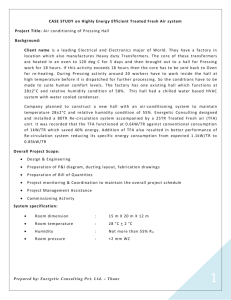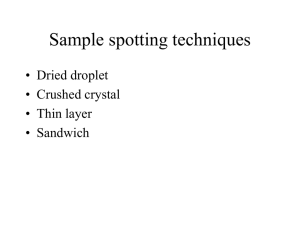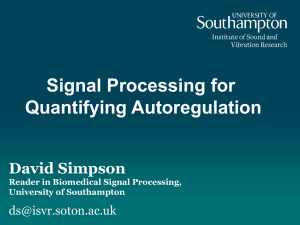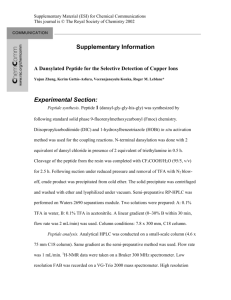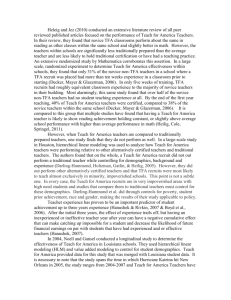etc_1925_sm_SupplData
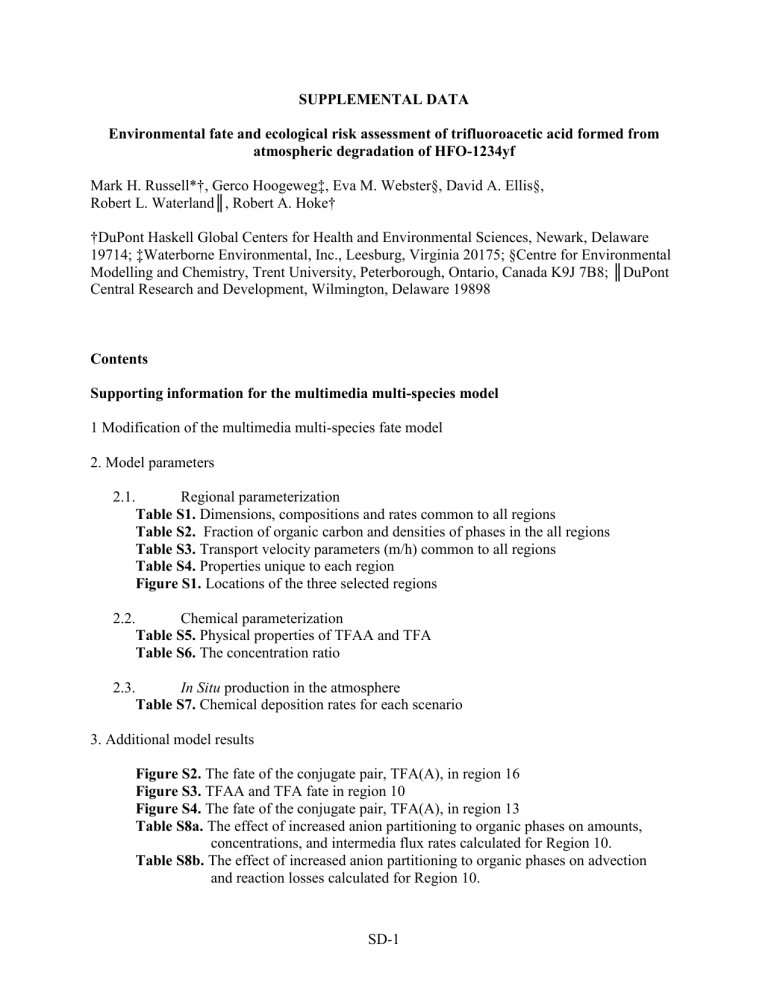
SUPPLEMENTAL DATA
Environmental fate and ecological risk assessment of trifluoroacetic acid formed from atmospheric degradation of HFO-1234yf
Mark H. Russell*†, Gerco Hoogeweg‡, Eva M. Webster§, David A. Ellis§,
Robert L. Waterland║, Robert A. Hoke†
†DuPont Haskell Global Centers for Health and Environmental Sciences, Newark, Delaware
19714; ‡Waterborne Environmental, Inc., Leesburg, Virginia 20175; §Centre for Environmental
Modelling and Chemistry, Trent University, Peterborough, Ontario, Canada K9J 7B8; ║DuPont
Central Research and Development, Wilmington, Delaware 19898
Contents
Supporting information for the multimedia multi-species model
1 Modification of the multimedia multi-species fate model
2. Model parameters
2.1. Regional parameterization
Table S1.
Dimensions, compositions and rates common to all regions
Table S2.
Fraction of organic carbon and densities of phases in the all regions
Table S3.
Transport velocity parameters (m/h) common to all regions
Table S4.
Properties unique to each region
2.2.
Figure S1.
Locations of the three selected regions
Chemical parameterization
Table S5.
Physical properties of TFAA and TFA
Table S6.
The concentration ratio
2.3. In Situ production in the atmosphere
Table S7.
Chemical deposition rates for each scenario
3. Additional model results
Figure S2.
The fate of the conjugate pair, TFA(A), in region 16
Figure S3.
TFAA and TFA fate in region 10
Figure S4.
The fate of the conjugate pair, TFA(A), in region 13
Table S8a.
The effect of increased anion partitioning to organic phases on amounts,
concentrations, and intermedia flux rates calculated for Region 10.
Table S8b.
The effect of increased anion partitioning to organic phases on advection
and reaction losses calculated for Region 10.
SD-1
3.1. Advection and rainfall
Table S9.
Relative TFA(A) loss rates
Table S10.
Calculated residence times of the air and water in each region
Table S11.
Chemical deposition, atmospheric advection, and fresh or marine water advection rates
Table S12. Comparison of air/water and rain/water concentration ratios calculated by the multimedia, multi-species model for three USA regions compared to monitoring results reported in Bayreuth, Germany, North American Great
Lakes and Lake Malawi in Africa
Supporting information for the GIS-based screening model
4. Information on global water distribution and characteristics of saline water bodies
Table S13.
Global water distribution
Table S14.
Predicted TFA concentration (µg/L) in terminal water bodies across the continental USA as a function of emission class, TFA half-life and emission duration
References
SD-2
Supporting information for the multimedia multi-species model
1. Modification of the multimedia multi-species fate model
The multimedia multi-species model used to calculate the fate of trifluoroacetic acid (TFAA) in equilibrium with its conjugate base, trifluoroacetate (TFA), produced by the atmospheric degradation of 2,3,3,3-tetrafluoropropene, was previously developed and tested for perfluorooctanoic acid in equilibrium with perfluorooctanoate (Webster et al., 2010). It was reparameterized to represent western, midwestern and eastern coastal regions of the USA and the calculation of the concentration ratio, CR , of each species in the phases of each compartment was modified to more accurately reflect TFA(A)s known behavior in soil and sediment. Specifically, the CR values were calculated as the ratio of the sum over all phases, i , of the product of mass of the species in the phase, m i
, and volume fraction of the phase, v i
, that is,
CR
i m i a v i
/
i m i n v i
(1)
The previously employed simplifying assumption was sufficiently accurate for PFO(A) with its less extreme properties. The modified model was tested and gives identical results to those published by Webster et al. (2010) for PFO(A).
2. Model parameters
2.1 Regional parameterization
Three regions of North America were selected as representative of the western, midwestern and east coast of the USA intended to represent scenarios of low, medium and high TFA(A) deposition rates as described by Luecken et al., (2010). The location of each region is indicated on Figure S1 and properties used in the model are given in Tables S1 to S4. For simplicity, a constant, uniform temperature of 20° C and the standard scavenging ratio of 2 × 10
5
m
3
of air / m 3 of rain were used for all regions.
SD-3
Table 1 . Dimensions, compositions and rates common to all regions. Parameters values are from Webster et al. (2010) except where noted.
Upper and Lower atmosphere
Height (at constant pressure)
Volume fraction of particulate
Lower atmosphere Air flow rate
Rain
Volume fraction in total atmosphere pH
Fraction originating in upper atmosphere lower atmosphere
Average droplet radius
Total volume of droplets
1 km
2 × 10 -11
m
3
/m
3
of air
0.5
6 × 10
4.5 a
-8
× Upper atmos. flow rate m
0.7 m
3
3
/m
/m
3
3
of air
of rain
Aqueous aerosols
Fresh and Marine water surface microlayers
Particulate
Number density pH
Depth
Particulate pH
Enrichment factor
Depth Fresh water column
Particulate
Sediment (Fresh water only)
Marine water column
Soil
Depth
Pore water pH of pore water
Solids
Depth
Particulate pH
Depth
Pore air
Pore water pH of pore water
Solids a MacLeod et al., 2001 b Ellis and Webster, 2010
0.3 m
3
/m
3
of rain
1
150 b
μm m
3
× fraction in water
1
20 a surface microlayer
10
7 airborne droplets / m
3
of air
× pH of fresh water
1
5 ×10 -5 m
× fraction in water
1 column
1
1 column
× pH of water column mol/m
3
per mol/m
3 m
5 × 10 -6 m
3
/m
3 of water
3 a cm
0.7 m
3
/m
3
of sediment
7.8
0.3 m
3
/m
3
of sediment
100 a m
5 × 10 -6 a
m
3
/m
3 of water
8.1 b
10 cm
0.2 m
3
/m
3
of soil
0.3 m
3
/m
3
of soil
6.5
0.5 m
3
/m
3
of soil
SD-4
Table 2. Fraction of organic carbon and densities of phases in the all regions based on MacLeod et al. (2001) and Webster et al. (2010).
Phase
Atmospheric particulate
Particulate in the fresh water
Sediment solids
Particulate in the marine water
Soil solids
Organic carbon fraction n/a
0.2
0.04
0.2
0.02
Density (kg/m
2400
2400
2400
2400
2400
3
)
Table 3 . Transport velocity parameters (m/h) common to all regions based on MacLeod et al.
(2001) and Webster et al. (2010).
Diffusion to stratosphere
Upper-lower atmosphere mixing
Air side air-fresh water MTC, k a
Water side air-fresh water MTC, k w
Atmospheric particulate deposition
Aqueous aerosol droplet production, k d
Aqueous aerosol droplet deposition (dry)
Air side air-aqueous aerosol droplet MTC
Water side air-aqueous aerosol droplet MTC
Fresh water surface-deeper mixing, k x
Fresh water deeper-surface mixing
Sediment-water diffusion MTC
Sediment deposition
Sediment re-suspension
Sediment burial
Air side air-marine water MTC
Water side air- marine water MTC
Marine water surface-deeper mixing, k x
Marine water deeper-surface mixing
Marine particle transfer to deep ocean
Soil air phase diffusion MTC
Soil water phase diffusion MTC
Soil air boundary layer MTC
Soil solids convection rate
Soil water runoff rate
Soil solids runoff rate
Leaching from soil
0.01
5
1
0.01
10.8
5 × 10 -6 k d k a k w
1 k x
0.0004
5 ×10 -7
2 ×10 -7
3 ×10 -7 k a k w k x k x
7 × 10 -8
0.04
0.00001
1
4 × 10 -7
0.4 × rain rate
0.0002 × rain rate
0.1 × rain rate
SD-5
Table 4. Properties unique to each region based on MacLeod et al. (2001) and Ellis and Webster
(2010).
Region name
(region number)
Upper atmosphere flow rate, m
3
/h
Fresh water flow rate, m
3
/h
Marine water flow rate, m
3
/h
Fresh to marine water flow rate, m
3
/h
Total area, km
2
Fresh water area, % of total
Marine water area, % of total
Rain rate, m/h
Fresh water pH
Sierra Nevada-
Pacific Coast
(16)
8.23 × 10 12
0
7 × 10 7
10
7
1.13 × 10 6
0.54
25.28
4.9 × 10
-5
8
Missouri &
Cheyenne Rivers
(10)
1.17 × 10 13
10
7
0
0
1.38 × 10 6
0.50
0
5.9 × 10 -5
8
Appalachian-
Atlantic Coast
(13)
1.18 × 10 13
0
7 × 10 7
10
7
7.76 × 10 5
0.36
38.11
4.3 × 10 -5
7.3
Figure 1. Locations of the three selected regions: Sierra Nevada-Pacific Coast (16), Missouri &
Cheyenne Rivers (10), and Appalachian-Atlantic Coast (13).
SD-6
2.2 Chemical parameterization
Chemical properties of partition coefficients, a dissociation constant, and degradation half-lives are needed by the model. For TFAA, a measured octanol-water partition coefficient, K
OW
, is cited by Boutonnet et al. (1999) from an internal report, but it is orders of magnitude lower than the quantitative structure-activity relationship (QSAR) estimates reported by VCCLab
(Mannhold et al., 2009; Tetko, 2005; Tetko et al., 2005; http://www.vcclab.org/ ). The average of the QSAR estimates is used here. The air-water partition coefficient, K
AW
, of TFAA was calculated from the recent reported Henry’s law constant of 5800±7700 mol dm -3
atm
-1
at 298.15
K (Kutsuna and Hori, 2008) that is consistent with the earlier measurement by Bowden et al.
(1996). The anion, TFA, in equilibrium with TFAA, is assumed to be confined to aqueous phases, i.e., unable to partition to non-aqueous phases. This condition is simulated by log K
OW and log K
AW
values of -24. This is the same assumption as was used in the modelling of perfluorooctanoic acid in equilibrium with its conjugate base, perfluorooctanoate (Webster et al.
2010). In that study it was demonstrated through a consideration of non-negligible partitioning of the anion to successfully represent the observed fate of the conjugate pair. None-the-less consistent with suggestions of a much higher log K
OW
of the anion (Jing et al., 2009; Rayne and
Forest, 2009; Trapp and Horobin (2005), a value of -2, was also considered here. Ions do not exist in the gas phase at standard temperature and pressure. Assuming a log K
AW
of the anion of -
24 adequately approximates the absence of partitioning to the gas phase in the environment.
Consistent with the environmental risk assessment of Boutonnet et al. (1999) and the literature cited therein, the conjugate pair, TFA(A), was assumed to not degrade in the environment. To simulate this condition, half-lives of 10
11
h were assigned to both species in all environmental media. These physical properties of TFAA and TFA required by the model are listed in Table S5.
For gas-particle partitioning, based on the environmental measurements of Martin et al. (2003), an empirical constant of 18.5 was used as described in Webster et al. (2010).
Table S5 : Physical properties of TFAA and TFA used in the model, assumed to apply at 25° C.
Molar mass, g/mol pK a log K
AW log K
OW
Degradation half-lives (all media), h
TFAA
114
0.2 a
-5.1 b
0.8 c
10
11 e
TFA
113 n/a
-24
d
-24
d
10
11 e a Kutsuna and Hori, 2008; b calculated from Kutsuna and Hori, (2008); c the logarithm of the average of the estimated K
OW
values reported by VCCLab (Mannhold et al., 2009; Tetko, 2005;
Tetko et al., 2005; http://www.vcclab.org/); d assumed; e value approximates no degradation, consistent with Boutonnet et al. (1999).
The [TFA]/[TFAA] concentration ratios, CR , in each compartment were calculated as described in Section 1 with results as listed in Table S6.
SD-7
Table S6: The concentration ratio, CR , as the amount of TFA relative to a unit amount of TFAA in each bulk compartment assuming only the neutral species can be present in non-aqueous phases.
Bulk compartment
Upper atmosphere
Lower atmosphere
Aqueous aerosol droplets
Surface freshwater
Deeper fresh water
Surface marine water
Deeper marine water
Soil
Sierra Nevada-
Pacific Coast (16)
4.43 × 10 -6
8.14 × 10 -7
6.31 × 10 7
6.31 × 10 7
6.31 × 10 7
7.94 × 10 7
7.94 × 10 7
1.86 × 10 6
3.84 × 10 7
Missouri & Cheyenne
Rivers (10)
4.43 × 10 -6
8.14 × 10 -7
6.31 × 10 7
6.31 × 10 7
6.31 × 10 7 n/a n/a
1.86 × 10 6
3.84 × 10 7
Appalachian-
Atlantic Coast (13)
4.43 × 10 -6
8.14 × 10 -7
1.26 × 10 7
1.26 × 10 7
1.26 × 10 7
7.94 × 10 7
7.94 × 10 7
1.86 × 10 6
3.84 × 10 7
Sediment n/a = does not apply
2.3 In Situ production in the atmosphere
Following from the work of Luecken et al. (2010), it was assumed that an emission to the lower atmosphere compartment in the model would most closely reflect the scenario of interest, that is, the in situ production of TFAA from 2,3,3,3-tetrafluoropropene (HFO-1234yf). To achieve these previously estimated deposition rates, listed in Table S7, the direct emission rates required by the model were adjusted until an accuracy of within 99.99 % of the listed deposition was calculated by the model, i.e., within a factor of at least 1.0001 (1 being perfect agreement). In the model results shown in Figures S2 to S4, it should be noted that mass balance is achieved for the conjugate pair TFA(A) within the error introduced by assuming the molar mass of TFAA for
TFA(A) in the unit conversion of rates for the conjugate pair from mol/h to kg/h. Mass balance is not expected nor seen for the individual species due to the interconversion between species that occurs in all aqueous phases.
Table S7 : Chemical deposition rates for each scenario based on Luecken et al. (2010) and the emission rates required by the model to achieve those deposition rates.
Sierra Nevada-Pacific Coast (16)
Missouri & Cheyenne Rivers (10)
Appalachian-Atlantic Coast (13)
Deposition rate, kg/km
2
0.4
1.0
1.6
Emission rate, kg/h
89.071
282.888
379.991
3. Additional model results
In all three scenarios, in the presence of both species, the model calculates that the majority of the TFA(A) accumulation is in a water body as shown in Figures S2 to S4. This high proportion in water (90-99%) is the combined result of the very low pK a
and very low K
AW
giving an overall distribution coefficient, D
AW
, for TFA(A) of between 10
-13
and 6 × 10
-13
m
3
/m
3
, for the modeled waters with pH values of 7.3-8.1, by the standard distribution equation for ionizing chemicals (Harris 2003). For the two coastal regions, the greatest accumulation occurs in the
SD-8
marine coastal waters. This is caused by the relative proportions of marine and fresh water in these regions. In the interior region where there is only fresh water, the highest fraction of the
TFA(A) is present in fresh water. Figure S3 (b) and (c) show the calculated concentrations, relative amounts, fluxes and losses of each species for the interior region. The properties of
TFAA is the primary determinant in the distribution of TFA(A) in the environment but the nonvolatility and hydrophilicity of TFA result in the high amounts present in water and resultant loss in water flowing from the region. Direct dissolution of TFAA in rain and subsequent deposition of TFA with the rain is responsible for the majority of the downward flux of TFA(A) (90.0, 92.8,
88.0% for regions 16, 10, and 13, respectively). This is consistent with the findings of Cahill and
Seiber (2000) and Berg et al. (2000). Direct partitioning of TFAA from the gas phase to the soil and water bodies is the next most important contributor to the downward flux of TFA(A). Runoff with water moves TFA(A) from soil to fresh water.
13.4
10
37
.0
0.29
10
Figure S2. The fate of the conjugate pair, TFA(A), in region 16 (Sierra Nevada-Pacific Coast) with an ‘emission’ to the lower atmosphere such that the requested chemical deposition rate for a western USA region is achieved.
SD-9
15
6.50
0.82
10
0 0
0 0
0.43
4
Figure S3. TFAA and TFA fate in region 10 (Missouri and Cheyenne Rivers), that is the concentrations, relative amounts, fluxes and losses of (a) TFAA and (b) TFA that combine to give the overall fate of TFA(A) in region 10 with an ‘emission’ of TFA(A) to the lower atmosphere such that the requested chemical deposition rate for a mid-western USA region is achieved.
SD-10
83
.18
0.52
10
55.25
10
Figure S4. The fate of the conjugate pair, TFA(A), in region 13 (Appalachian-Atlantic Coast) with an ‘emission’ to the lower atmosphere such that the requested chemical deposition rate for an east coast USA region is achieved.
The effect of increasing the log K
OW
of the anion, K
OW
(anion), from the assumed value of -24 to
-2 can be seen in Table S8 where concentrations, amounts, and fluxes of TFA(A), TFAA, and
TFA are given for Region 10 for both scenarios. The relative amounts (%) of TFA(A) were not affected by the increase in anion partitioning with the exception of an increase in the relative amount of TFAA in soil at the higher K
OW
(anion). As can be seen from the logarithm of the concentrations (mol/m
3
), this relative increase is in a very small concentration, and therefore is, itself, unimportant. The concentrations of TFAA in the deeper water and in the sediment also show an increase with increased K
OW
(anion). Again, these concentration increases are not important because they apply to values that are many orders of magnitude less than, for example, the concentrations of TFA in these media. Fluxes of TFA(A) between environmental compartments were unchanged with the exception of three relatively unimportant fluxes, namely aqueous aerosol droplets to air, surface water to air, and soil to air. These are the three lowest fluxes in the system. For TFAA and TFA, separately, other fluxes also show differences but the same pattern of large differences in relatively unimportant fluxes is observed. Of the advective losses of TFA(A) only sediment burial showed an increase but this is an unimportant removal process relative to atmospheric transport, for example. Degradation rates of TFA(A) were assumed to be effectively infinite and are therefore not relevant in the current context. Consistent
SD-11
with the Webster et al. (2010) study of a long chain perfluorinated carboxylic acid and its conjugate base, the overall distribution of the acid:base pair, TFA(A), can be understood through the partitioning of the neutral species, TFAA, without consideration of any partitioning by the anion to organic phases.
Table S8a.
The effect of increased anion partitioning to organic phases on amounts, concentrations, and intermedia flux rates calculated for Region 10. log K
OW
(anion)
Amounts, %
-24
TFA(A)
-2.7 -24
TFAA
-2.7 -24
TFA
-2.7
Upper atmosphere
Lower atmosphere
Aqueous aerosol droplets
Surface fresh water
Deeper fresh water
Soil
0.28
1.03 n n
0.28
1.03 n n
90.28 90.28
8.32 8.32
21.16
78.84 n n n n
21.14
78.78 n n n n n n n
91.48
0.07 8.43 n n n n
91.47
8.43
Sediment log (Concentration, mol/m
3
)
Upper atmosphere
0.09 0.09
TFA(A) n n 0.10 0.10
TFAA TFA
-10.47 -10.47 -10.47 -10.47 -15.83 -15.83
Lower atmosphere
Aqueous aerosol droplets
Surface fresh water
-9.90
-6.25
-3.96
-9.90
-6.25
-3.96
-9.90
-14.05
-11.76
-9.90
-14.05
-11.67
-15.99
-6.25
-3.96
-15.99
-6.25
-3.96
Deeper fresh water
Soil
Sediment log (Flux, mol/h)
Upper air to lower air
Upper air to fresh water
Upper air to soil
Lower air to upper air
-3.96 -3.96 -11.76 -11.67 -3.96
-4.99 -4.99 -11.26 -8.92 -4.99
-3.96
-4.99
-4.11 -4.11 -11.70 -8.33 -4.11
TFA(A) TFAA TFA
-4.11
2.67 2.67 2.67 2.67 -0.69
-3.55 -3.55 -3.55 -3.55 -31.43
-1.25 -1.25 -1.25 -1.25 -29.13
2.94 2.94 2.94 2.94 -3.15
-0.69
-9.43
-7.13
-3.15
Lower air to aerosol (aq)
Lower air to fresh water
Lower air to soil
Aerosol (aq) to lower air
-1.25
0.86
3.14
-1.25
0.86
-1.25
0.86
3.14 3.14
-1.25
0.86
-23.59
-2.64
3.14 -0.34
-23.59
-2.64
-0.34
-10.50 -21.14 -10.50 -21.32 -21.60 -21.60
Aerosol (aq) to soil 0.58 0.58 -7.22 -7.22 0.58
Aerosol (aq) to fresh water -1.72 -1.72 -9.52 -9.52 -1.72
SML to lower air
0.58
-1.72
-7.02 -6.93 -7.02 -6.93 -18.12 -18.12
SML to aerosol (aq)
SML to fresh water
Fresh water to sediment
Fresh water to SML
Soil to lower air
Soil to fresh water
Sediment to fresh water n = less than 0.01%
0.58
5.88
2.48
5.88
0.58
5.88
2.48
5.88
-7.22
-1.92
-5.32
-1.92
-7.13
-1.83
-5.23
-1.83
0.58
5.88
2.48
5.88
0.58
5.88
2.48
5.88
-4.02 -1.68 -4.02 -1.68 -16.33 -16.33
3.04 3.04 -3.30 -0.96 3.04 3.04
2.48 2.48 -5.14 -1.78 2.48 2.48
SD-12
Table S8b.
The effect of increased anion partitioning to organic phases on advection losses calculated for Region 10. log K
OW
(anion) log (Advection loss, mol/h)
Transfer to stratosphere
Upper atmosphere
Lower atmosphere
Aqueous aerosol droplets
Surface fresh water
Deeper fresh water
Leaching from Soil
Sediment Burial
-24 -2.7
TFA(A)
-24
TFAA
-2.7 -24
TFA
-2.7
-0.34 -0.34 -0.34 -0.34 -22.31 -22.31
2.59 2.59 2.59 5.59 -2.76 -2.76
2.86 2.86 2.86 2.86 -3.23 -3.23
-6.45 -6.45 -14.25 -14.25 -6.45
-2.56 -2.56 -10.36 -10.27 -2.56
3.04
2.44
3.04
2.44
-4.76
-3.90
-4.76
-1.56
3.04
2.44
-8.94 -4.10 -8.94 -5.57 -26.12
-6.46
-2.56
3.04
2.44
-4.12
3.1 Advection and rainfall
With the assumption of no degradation of either chemical species in the model, only advective processes are available to remove chemical from the system and thus maintain steady state concentrations inherent in the model design. It is convenient to consider these losses as a fraction of the emission rate, as shown in Table S9. In the coastal regions (16 and 13) there are two major routes for the TFA(A) from emission into air: advection out in air, and deposition to soil and marine waters, and to a lesser extent runoff to fresh water, and runoff into marine water where it then advects out of the region. For the interior region, in the absence of a marine compartment, the TFA(A) that would have advected out of the region in the marine water, does so in the fresh water. The region downwind or downstream can be considered to be receiving emissions into the atmosphere and into the waterbodies at rates equal to the rates of advection out of the original region. Thus, in the absence of additional production of TFAA in the atmosphere of the receiving region, the fraction of the original ‘emission’ is again reduced during transit through the receiving region.
Atmospheric and water residence times can be calculated from the model input parameters of area, and air and water flow rates for each region (given in Table S4). The residence time of air in the upper and lower compartments is on the order of days while the residence time of the fresh and marine water compartments is on the order of years (Table S10). In each scenario, the rate of atmospheric advection of TFA(A) is compared to the rate of deposition of TFA(A) from the atmosphere to soil and water and subsequent advection in water (Table S11). For regions 16 and
10, these rates are very similar but for region 13, the eastern coastal region, atmospheric advection loss is substantially higher than the deposition or loss by advection in water. This difference is consistent with the much shorter residence time of the air in region 13 as compared to that in regions 16 or 10 (Table S10). In considering these regions in the larger global context, if half of the TFA(A) ‘emitted’ in a region (1) is carried by atmospheric advection to a similar neighbouring region (2), half of the remaining atmospheric concentration, or a quarter of the original ‘emission’ can be expected to advect into atmosphere of the next region (3). Thus the fraction of the original ‘emission’ remaining in the atmosphere is progressively reduced.
SD-13
Table S9.
Relative TFA(A) loss rates by advection as a percentage of the emission rate to the region.
Region name
(region number)
Sierra Nevada-
Pacific Coast
(16)
Missouri &
Cheyenne Rivers
(10)
Appalachian-
Atlantic Coast
(13)
Atmospheric loss
Transfer to stratosphere
Upper atmosphere advection
Lower atmosphere advection
Aqueous aerosol advection
Subtotal:
Water loss
Fresh water advection
Marine water advection
Fresh surface water advection
Marine surface water advection
Transfer to deep ocean w/ particulate
Subtotal:
Soil and sediment loss
Leaching from soil
Sediment burial
0.02
18.27
30.30 n
48.60 n
44.75 n n n
44.75
7.53 n
0.02
15. 80
29.43 n
45.25
44.54 n n n n
44.54
11.10 n
Subtotal: n = rate is less than 0.01% of the emission rate
7.53 11.10 4.46
Table S10 . Calculated residence times of the environmental media: air and water in each region.
Note that the residence times for the atmosphere are on the order of days while those for water are on the order of years. n n n
32.11
4.46 n
0.01
18.90
45.40 n
64.31 n
32.11
Region name
(region number)
Upper atmosphere
Lower atmosphere
Fresh water
Marine water
Sierra Nevada-
Pacific Coast
(16)
5.7 d
11.4 d n/a
46.6 y
Missouri &
Cheyenne Rivers
(10)
4.9 d
9.9 d
1.6 y n/a
Appalachian-
Atlantic Coast
(13)
2.7 d
5.5 d n/a
48.2 y
SD-14
Table S11 . Chemical deposition, atmospheric advection, and fresh or marine water advection rates (kg/h) are compared.
Region name
(region number)
Sierra Nevada-
Pacific Coast
(16)
Missouri &
Cheyenne Rivers
(10)
Appalachian-
Atlantic Coast
(13)
Deposition
Atmospheric advection
Water advection
51.56
43.29
39.86
157.82
128.00
125.99
141.64
244.39
122.00
The proportion of the ‘emitted’ TFA(A) transported out of each region in the atmosphere is at least comparable to that transported in the water compartments. This suggests that deposition processes may not remove TFA(A) from the air as rapidly as expected. However, the upward flux processes have very low rates (Figures S2 to S4) relative to the downward flux rates suggesting that, once in the water, little will return to the atmosphere. To test this, an emission to the water in the interior region was modeled. In this scenario, with no direct emission to the atmosphere, approximately 100% of the total emission is advected out of the region in the water, as must be expected for such a low D
AW
value.
The apparently slow rate of deposition is strongly dependent upon the model assumption of a constant but very low rain rate equivalent to the average rainfall. If this constant drizzle is replaced by a rain event of 30 mm over the course of one day, this equates to a rain rate 0.72 m/h. Applying this to region 10 (the interior region), the concentration in upper atmosphere is reduced by approximately seven orders of magnitude and in the lower atmosphere by nearly four orders of magnitude. The total deposition rate is increased by a factor of 1.8. Approximately 80% of the ‘emitted’ TFA(A) is transported out of the region with the water and 20% is removed by leaching in soil. By contrast, during periods of no rain, the concentration in the atmosphere is approximately twice that in the standard (constant drizzle) scenario, total deposition is reduced by a factor of seven, and advection in the air accounts for 95% of the removal from the region
(advection in water accounts for 4% of the total loss from the system). The results of the two extreme scenarios modeled here suggest that nearly 100% of the TFA(A) is deposited with the rain during a rain event and that nearly 100% of the TFA(A) remains in the atmosphere between rain events and undergoes atmospheric advection. Thus the efficacy of rain in the removal of
TFA(A) from the atmosphere is approximately unity during a rain event. Alternately, this effect can be described by the residence time in the atmosphere due to rain, R, as 1/ (k rain
) where k rain
is the rate constant for deposition of TFA(A) in rain. Between rain events R is effectively infinite
(on the order of millennia), with the constant drizzle assumption R is on the order of days, and during a rain event R is on the order of minutes. This is consistent with the findings of Jolliet and
Hauschild (2005) whose modeling predicted that during rain events persistent (non-ionizing) chemicals with very low K
AW
would have a residence time equal to (or longer than) the interval between rain events, and a near-zero residence time during a rain event. (The application of a multimedia model such as the one used here avoids the necessity for corrections such as that suggested by Jolliet and Hauschild (2005) for chemicals of very low K
AW
.) Clearly, depending upon the simulated intensity, duration of, and time between rain events, TFA(A) is either effectively scavenged from the atmosphere locally or over a broader geographic area which is consistent with the properties of this conjugate pair of chemicals, especially their log D
AW
of -13, and meteorological conditions.
SD-15
Supporting information for the GIS-based screening model
4. Information on global water distribution and characteristics of saline water bodies
Table S13.
Global water distribution
Environmental Compartment
Volume
(1000 km 3 )
Salinity
(o/oo) a
Percent b
Freshwater
Glaciers, ice, snow
Groundwater
Lakes, rivers
Atmosphere
Saline
Oceans
Groundwater
24,364
10,547
105
13
1,338,000
12,870
< 0.5
< 0.5
< 0.5
< 0.5
30 - 38
3 - 300
1.8
0.76
0.008
0.0009
96.5
0.93
Lakes 85 3 - 300 0.006 a Parts per thousand b Gleith, P.H.; 1996. Water resources. In Encylopedia of Climate and Weather, ed. By S.H. Schneider, Oxford
University Press, New York, Vol. 2, 817-823.
SD-16
Table S14.
Predicted TFA concentration (µg/L) in terminal water bodies across the continental
USA as a function of emission class, TFA half-life and emission duration
Emission TFA Half-life class (yrs) 5 yrs
Duration of emissions
10 yrs 50 yrs upperbound
(high) lower- bound
(low)
Typical result (0 to ~99% of land area)
10
20 stable
1-3
1-4
1-4
1-5
1-6
1-7
1-10
1-15
1-40
Worst case result (~99 to ~99.98% of land area)
10 5-15 5-25 15-50
20 stable
5-15
5-20
10-30
10-40
20-75
50-200
Typical result (0 to ~99% of land area)
10
20 stable
1-2
1-2
1-3
1-4
1-5
1-5
1-7
1-13
1-25
Worst case result (~99 to ~99.98% of land area)
10 3-10 5-20 10-30
20 stable
3-10
4-15
5-20
5-25
15-60
30-125
SD-17
References
Berg, M., Müller, S.R., Mühlemann, J., Wiedmer, A., Schwarzenbach, R.P. 2000. Concentrations and mass fluxes of chloroacetic acids and trfluoroacetic acid in rain and natural waters in
Switzerland. Environ. Sci. Technol. 34, 2675-2683.
Boutonnet, J.C., Bingham P, Calamari D, de Rooij, C., Franklin, J., Kawano, T., Libre, J.-M.,
McCul-loch, A., Malinverno, G., Odom, J.M., Rusch, G.M., Smythe, K., Sobolev, I., Thompson,
T., Tiedje, J.M. 1999. Environmental risk assessment of trifluoroacetic acid. Hum. Ecol. Risk
Assess. 5, 59-124.
Bowden, D.J., Clegg, S.L., Brimblecombe, P. 1996. The Henry’s law constant of trifluoroacetic acid and its partitioning into liquid water in the atmosphere. Chemosphere. 32, 405-420.
Cahill, T.M., Seiber, J.N. 2000. Regional distribution of trifluoracetate in surface waters downwind of urban areas in northern California, U.S.A. Environ. Sci. Technol. 34, 2909-2912.
Ellis, D.A., Webster, E. Modelling the Environmental Fate of Ionizing Surfactants: Final report to Procter & Gamble. June 30, 2010.
Ellis, D.A., Mabury, S.A. 2000. The aqueous photolysis of TFM and related trifluoromethylphenols. An alternate source of trifluoroacetic acid in the environment. Environ.
Sci. Technol. 34, 632–637.
Frank, H., Klein, A., Renschen, D., 1996. Environmental trifluoroacetate. Nature 382, 34.
Harris, D.C. 2003. Quantitative Chemical Analysis, 6th ed. W.H. Freeman and Company, NY. pp 550-551.
Jing, P., Rodgers, P.J., Amemiya S. 2009. High lipophilicity of perfluoroalkyl carboxylate and sulfonate: Implications for their membrane permeability. J. Am. Chem. Soc. 131, 2290-2296.
Jolliet, O., Hauschild, M. 2005. Modeling the influence of intermittent rain events on long-term fate and transport of organic air pollutants. Environ. Sci. Technol. 39, 4513-4522.
Jordan, A., Frank, H. 1999. Trifluoroacetate in the environment. Evidence for sources other than
HFC/HCFCs. Environ. Sci. Technol. 33, 522-527.
Kutsuna, S., Hori, H. 2008. Experimental determination of Henry’s law constants of trifluoroacetic acid at 278–298K. Atmos. Environ. 42, 1399-1412.
Luecken, D.J., Waterland, R.L., Papasavva, S., Taddonio, K.N., Hutzell, W.T., Rugh, J.P.,
Andersen, S.O. 2010. Ozone and TFA impacts in North America from degradation of 2,3,3,3tetrafluoropropene (HFO-1234yf), a potential greenhouse gas replacement. Environ. Sci.
Technol. 44, 343–348
SD-18
Mackay, D. 2010. Personal communication regarding error in Table 1 of Toose et al. (2004).
June 4, 2010.
MacLeod, M., Woodfine, D., Mackay, D., McKone, T., Bennett, D., Maddalena, R. 2001. BETR
North America: a regionally segmented multimedia contaminant fate model for North America.
Environ. Sci. Pollut. Res. 8, 156 - 163.
Mannhold, R., Poda, G.I., Ostermann, C., Tetko, I.V. 2009. Calculation of molecular lipophilicity: State-of-the-art and comparison of Log P methods on more than 96,000 compounds. J. Pharm. Sci. 98, 861–893.
Martin, J.W., Mabury, S.A., Wong, C.S., Noventa, F., Solomon, K.R., Alaee, M, Muir, D.C.G.,
2003. Airborne haloacetic acids. Environ. Sci. Technol .
37(13) 2889-2897.
Rayne S., Forest, K. 2009. Perfluoroalkyl sulfonic and carboxylic acids: A critical review of physicochemical properties, levels and patterns in waters and wastewaters, and treatment methods. Journal of Environmental Science and Health Part A. 44, 1145-1199.
Seth, R., Mackay, D., Muncke, J. 1999. Estimating the organic carbon partition coefficient and its variability for hydrophobic chemicals. Environ. Sci. Technol. 33, 2390–2394.
Scott, B.F., Spencer, C., Marvin, C.H., MacTavish, D.C., Muir, D.C.G. 2002. Distribution of haloacetic acids in the water columns of the Laurentian Great Lakes and Lake Malawi. Environ.
Sci. Technol.
36, 1893-4898.
Trapp S., Horobin R.W. 2005. A predictive model for the selective accumulation of chemicals in tumor cells. Eur. Biophys. J. 34, 959-966.
Tetko, I.V. 2005. Virtual Computational Chemistry Laboratory. Neuherberg, Germany
Tetko, I.V., Gasteiger, J., Todeschini, R., Mauri, A., Livingstone, D., Ertl, P., Palyulin, V.A.,
Radchenko, E.V., Zefirov, N.S., Makarenko, A.S., Tanchuk, V.Y., Prokopenko, V.V. 2005.
Virtual computational chemistry laboratory – design and description. J. Comput. Aided Mol.
Des. 19, 453–463.
Toose, L., Woodfine, D.G., MacLeod, M., Mackay, D., Gouin, J. 2004. BETR-World: a geographically explicit model of chemical fate: application to transport of α-HCH to the arctic.
Environ. Pollut. 128, 223-240.
Webster, E., Ellis, D.A., Reid, L.K. 2010. Modeling the environmental rate of perfluorooctanoic
Acid and perfluorooctanoate: an investigation of the role of individual species partitioning.
Environ. Toxicol. Chem. 29, 1466–1475.
SD-19
